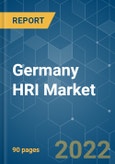The Germany HRI market is poised to register a CAGR of 2.34% during the forecast period (2020 - 2025).
Key Highlights
- The market is primarily driven by the increasing inclination and investment toward technological developments, such as robotics, Internet of Things (IoT), blockchain, and others, and are simplifying the food industry in Germany.
- Moreover, foodservice establishments are developing a customer-centric approach or strategies, to increase the repetitive orders from them. Personalization, indulgence toward healthy eating habits, and reduction of food wastage have become some of the major concentration points for the restaurants and other foodservice organizations in the market.
- However, the increasing labor cost and food prices, the effect of Brexit, and increased cases for restaurant closures are restraining the market in the European region, which can further hamper its growth during the forecast period.
Key Market Trends
Institutional (Catering) Segment To Drive The Market
The institutional (catering) segment is witnessed to hold the major share in the Germany HRI market. The institutional catering includes education, healthcare, business catering, schools, hospitals, factory restaurants, and air and sea catering. In order to gain consumer interest, universities in the country are focusing on reforming their cafeterias, in terms of ambience, digitalized payment modes, and food ordering methods. This is driving the demand for catering in schools and colleges across the country. In addition, the increased demand for catering is primarily due to the booming economy of the country, maturing population, and increased number of parties organized by foreign missions. This segment engages in the provision of high-quality food at competitive prices. This segment primarily includes caterers. The major catering companies in the country include Compass, Aramark, Sodexo, Apetito, and Klüh, among others.
Growing Demand For Fast Food In The Germany HRI Market
Owing to hectic lifestyles, German consumers prefer to dine out more often. For instance, at breakfast time, teatime, or late in the night. Furthermore, fast food outlets are at an advantage, as compared to full-service restaurants, as the time taken for the preparation of food is less, along with affordability. Furthermore, major players, like KFC, McDonald's, and Burger King, are witnessing rapid growth, as compared to independent players. Restaurant chains are focusing on expanding their presence in major and smaller cities, along with strong presence in locations, like shopping malls, airports, and bus stations. For instance, Burger King is planning to expand its presence, along German petrol stations, after signing a cooperation agreement with Esso, a petrol station operator in Europe.
Competitive Landscape
The German HRI market is fragmented. Emphasis is given on the merger, expansion, acquisition, and partnership of the companies along with new product development as strategic approaches adopted by the leading companies to boost their brand presence among consumers. For instance, Domino’s Pizza acquired 170 stores from Hallo Pizza in Germany, the largest independent pizza chain in the country. This acquisition helped the company to boost its market position. by increasing the store count.
Additional Benefits:
- The market estimate (ME) sheet in Excel format
- 3 months of analyst support
This product will be delivered within 2 business days.
Table of Contents
Methodology

LOADING...








